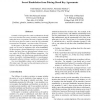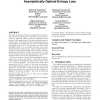15 search results - page 3 / 3 » One-Way and Two-Party Authenticated ID-Based Key Agreement P... |
SP
2003
IEEE
13 years 10 months ago
2003
IEEE
Consider a CIA agent who wants to authenticate herself to a server, but does not want to reveal her CIA credentials unless the server is a genuine CIA outlet. Consider also that t...
SCN
2010
Springer
13 years 3 months ago
2010
Springer
We introduce a protocol, that we call Human Key Agreement, that allows pairs of humans to establish a key in a (seemingly hopeless) case where no public-key infrastructure is avail...
STOC
2010
ACM
13 years 8 months ago
2010
ACM
We study the problem of "privacy amplification": key agreement between two parties who both know a weak secret w, such as a password. (Such a setting is ubiquitous on th...
CRYPTO
2005
Springer
13 years 11 months ago
2005
Springer
Abstract. We propose a way to establish peer-to-peer authenticated communications over an insecure channel by using an extra channel which can authenticate very short strings, e.g....
TIFS
2011
13 years 7 days ago
2011
— “Pairing” is the establishment of authenticated key agreement between two devices over a wireless channel. Such devices are ad hoc in nature as they lack any common preshar...


